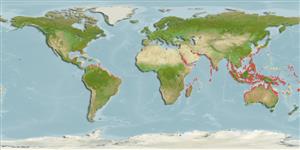Bivalvia |
Ostreida |
Ostreidae
Environment: milieu / climate zone / djupintervall / distribution range
Ekologi
; djupintervall 0 - 5 m (Ref. 348). Tropical
Indo-West Pacific.
Length at first maturity / Size / Weight / Age
Könsmognad: Lm ? range ? - ? cm Max length : 8.4 cm SHL hane/ej könsbestämd; (Ref. 122433); common length : 6.0 cm SHH hane/ej könsbestämd; (Ref. 348)
Maximum shell height is 12 cm (Ref. 348). Cemented on various hard substrates or objects. Intertidal and shallow subtidal waters (Ref. 348). Associated with dead coral heads (Ref. 75840).
Life cycle and mating behavior
Könsmognad | Reproduktion | Lek | Eggs | Fecundity | Larvae
Members of the class Bivalvia are mostly gonochoric, some are protandric hermaphrodites. Life cycle: Embryos develop into free-swimming trocophore larvae, succeeded by the bivalve veliger, resembling a miniature clam.
Poutiers, J.M. 1998 Bivalves. Acephala, Lamellibranchia, Pelecypoda. p. 123-362. In Carpenter, K. E. and V. H. Niem. 1998. FAO species identification guide for fishery purposes. The living marine resources of the Western Central Pacific. Volume 1. Seaweeds, corals, bivalves, and gastropods. Rome, FAO. (Ref. 348)
IUCN Red List Status
(Ref. 130435: Version 2025-1)
CITES status (Ref. 108899)
Not Evaluated
Not Evaluated
Threat to humans
Harmless
Human uses
| FishSource |
Verktyg
Ytterligare information
Trophic EcologyFood items (preys)
Födosammansättning
Födointag
Predatorer
Population dynamicsTillväxtMax. ages / sizesLength-weight rel.Length-length rel.Length-frequenciesMass conversionAbundans PhysiologySyreförbrukning
Human RelatedStamps, coins, misc.
Internet-källor
Estimates based on models
Preferred temperature
(Ref.
115969): 24 - 29.3, mean 28 (based on 3924 cells).
Fishing Vulnerability
Low vulnerability (10 of 100).
Price category
Unknown.
